ECON 214: Problem Set on Money, Banking, and Monetary Policy
VerifiedAdded on 2023/06/15
|9
|1586
|422
Homework Assignment
AI Summary
This assignment solution delves into key concepts of economics, starting with an exploration of the three primary functions of money: medium of exchange, unit of account, and store of value, emphasizing the medium of exchange as the most critical. It differentiates between the federal funds rate and the discount rate as tools used by the Federal Reserve in setting monetary policy. Through a series of balance sheet adjustments for Wahoo Bank, the assignment illustrates the impact of withdrawals and Federal Reserve actions on required reserves, excess reserves, and loan amounts. Furthermore, it analyzes scenarios involving money deposits and government securities purchases to determine their effects on the money supply, highlighting how direct purchases from banks lead to greater increases due to the elimination of required reserve holdings. The assignment concludes by calculating the value of government securities needed to be purchased to achieve a specific increase in the money supply, given a required reserve ratio. Desklib provides access to this and many other solved assignments for students.
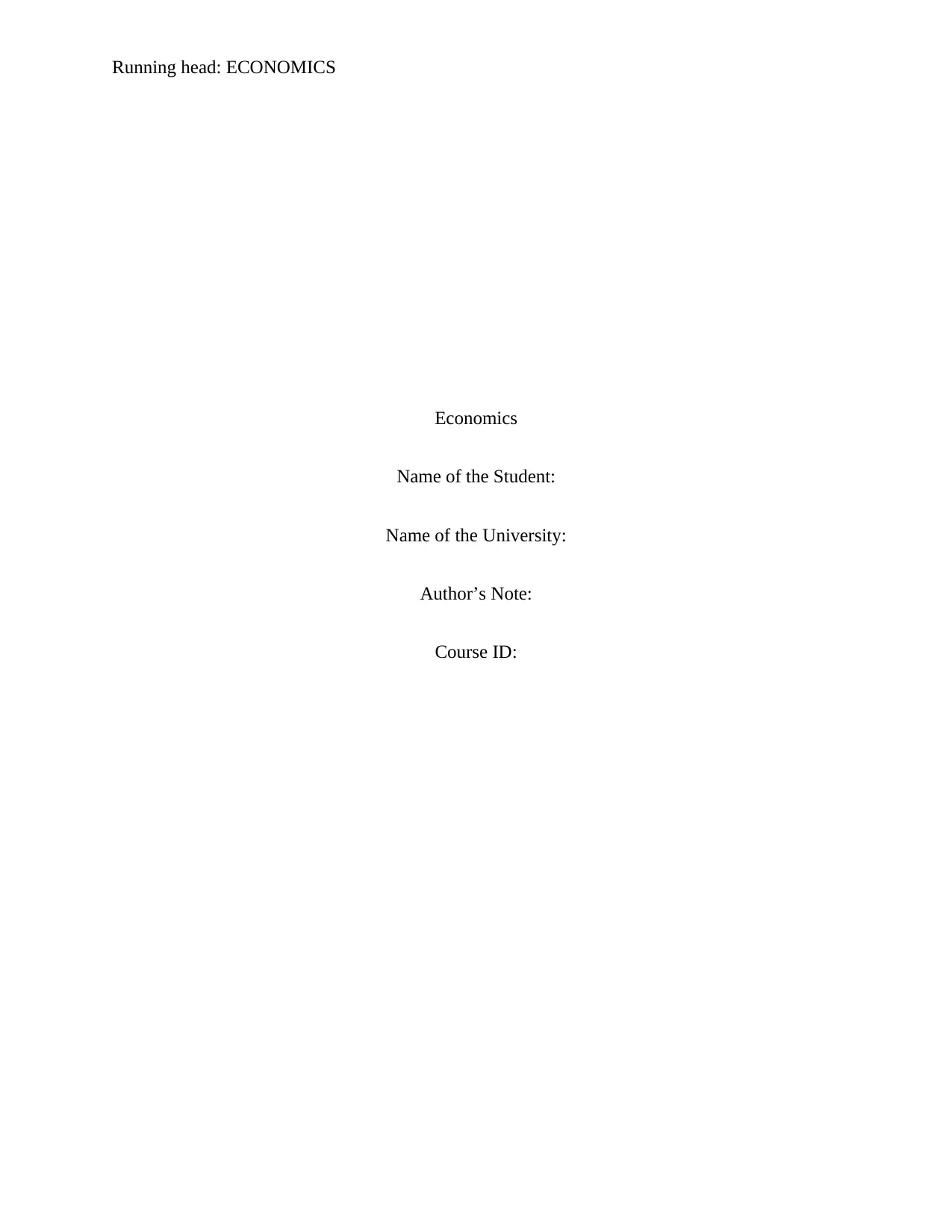
Running head: ECONOMICS
Economics
Name of the Student:
Name of the University:
Author’s Note:
Course ID:
Economics
Name of the Student:
Name of the University:
Author’s Note:
Course ID:
Paraphrase This Document
Need a fresh take? Get an instant paraphrase of this document with our AI Paraphraser
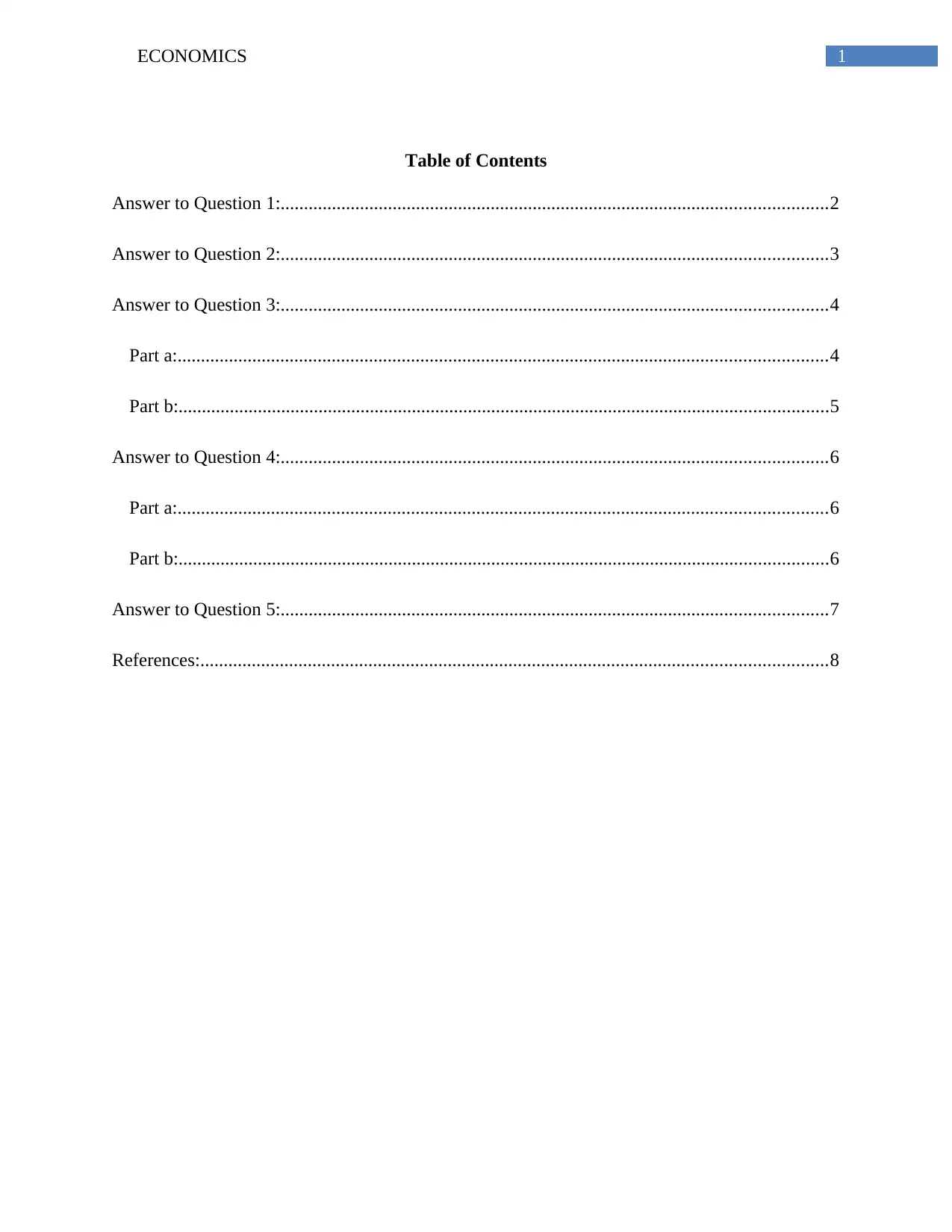
1ECONOMICS
Table of Contents
Answer to Question 1:.....................................................................................................................2
Answer to Question 2:.....................................................................................................................3
Answer to Question 3:.....................................................................................................................4
Part a:...........................................................................................................................................4
Part b:...........................................................................................................................................5
Answer to Question 4:.....................................................................................................................6
Part a:...........................................................................................................................................6
Part b:...........................................................................................................................................6
Answer to Question 5:.....................................................................................................................7
References:......................................................................................................................................8
Table of Contents
Answer to Question 1:.....................................................................................................................2
Answer to Question 2:.....................................................................................................................3
Answer to Question 3:.....................................................................................................................4
Part a:...........................................................................................................................................4
Part b:...........................................................................................................................................5
Answer to Question 4:.....................................................................................................................6
Part a:...........................................................................................................................................6
Part b:...........................................................................................................................................6
Answer to Question 5:.....................................................................................................................7
References:......................................................................................................................................8
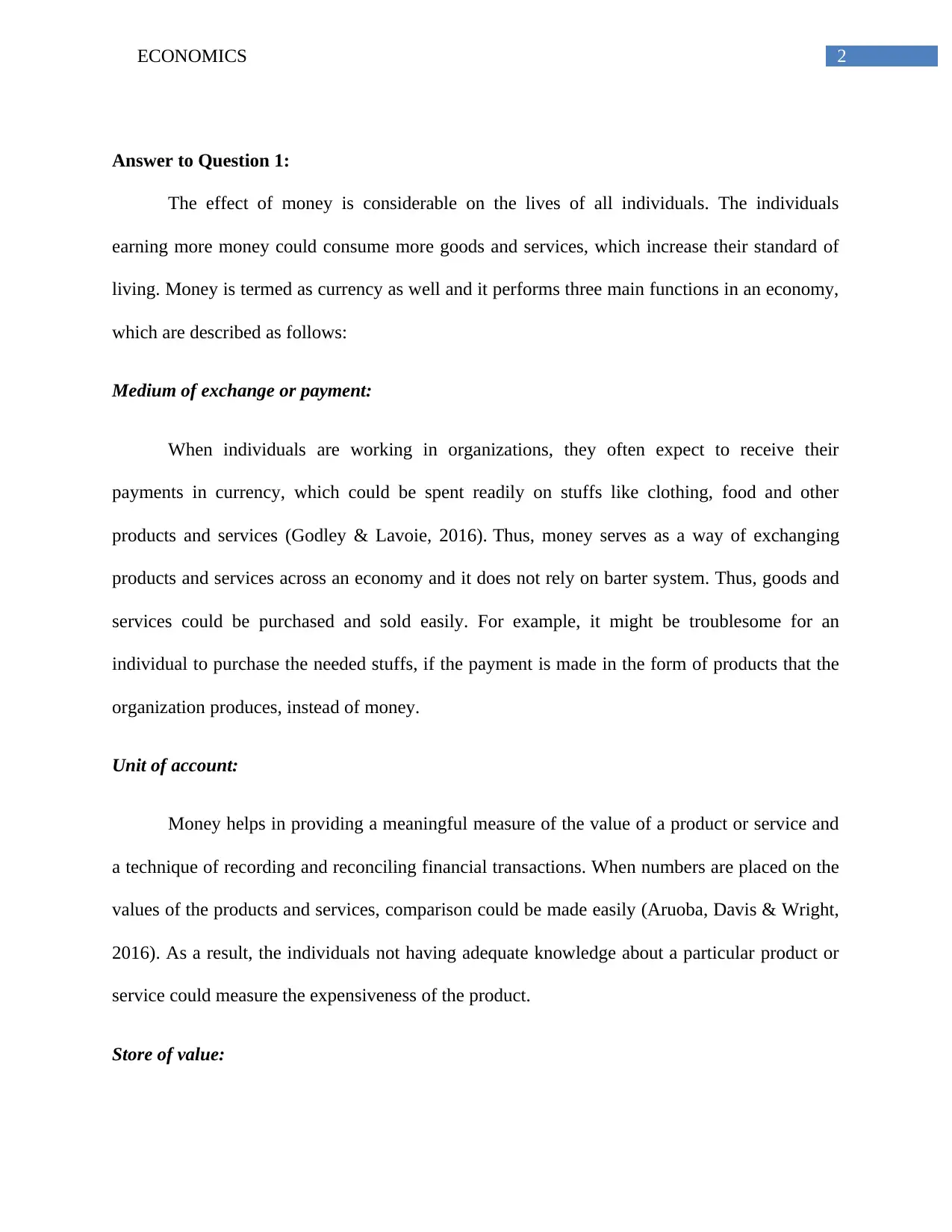
2ECONOMICS
Answer to Question 1:
The effect of money is considerable on the lives of all individuals. The individuals
earning more money could consume more goods and services, which increase their standard of
living. Money is termed as currency as well and it performs three main functions in an economy,
which are described as follows:
Medium of exchange or payment:
When individuals are working in organizations, they often expect to receive their
payments in currency, which could be spent readily on stuffs like clothing, food and other
products and services (Godley & Lavoie, 2016). Thus, money serves as a way of exchanging
products and services across an economy and it does not rely on barter system. Thus, goods and
services could be purchased and sold easily. For example, it might be troublesome for an
individual to purchase the needed stuffs, if the payment is made in the form of products that the
organization produces, instead of money.
Unit of account:
Money helps in providing a meaningful measure of the value of a product or service and
a technique of recording and reconciling financial transactions. When numbers are placed on the
values of the products and services, comparison could be made easily (Aruoba, Davis & Wright,
2016). As a result, the individuals not having adequate knowledge about a particular product or
service could measure the expensiveness of the product.
Store of value:
Answer to Question 1:
The effect of money is considerable on the lives of all individuals. The individuals
earning more money could consume more goods and services, which increase their standard of
living. Money is termed as currency as well and it performs three main functions in an economy,
which are described as follows:
Medium of exchange or payment:
When individuals are working in organizations, they often expect to receive their
payments in currency, which could be spent readily on stuffs like clothing, food and other
products and services (Godley & Lavoie, 2016). Thus, money serves as a way of exchanging
products and services across an economy and it does not rely on barter system. Thus, goods and
services could be purchased and sold easily. For example, it might be troublesome for an
individual to purchase the needed stuffs, if the payment is made in the form of products that the
organization produces, instead of money.
Unit of account:
Money helps in providing a meaningful measure of the value of a product or service and
a technique of recording and reconciling financial transactions. When numbers are placed on the
values of the products and services, comparison could be made easily (Aruoba, Davis & Wright,
2016). As a result, the individuals not having adequate knowledge about a particular product or
service could measure the expensiveness of the product.
Store of value:
⊘ This is a preview!⊘
Do you want full access?
Subscribe today to unlock all pages.

Trusted by 1+ million students worldwide
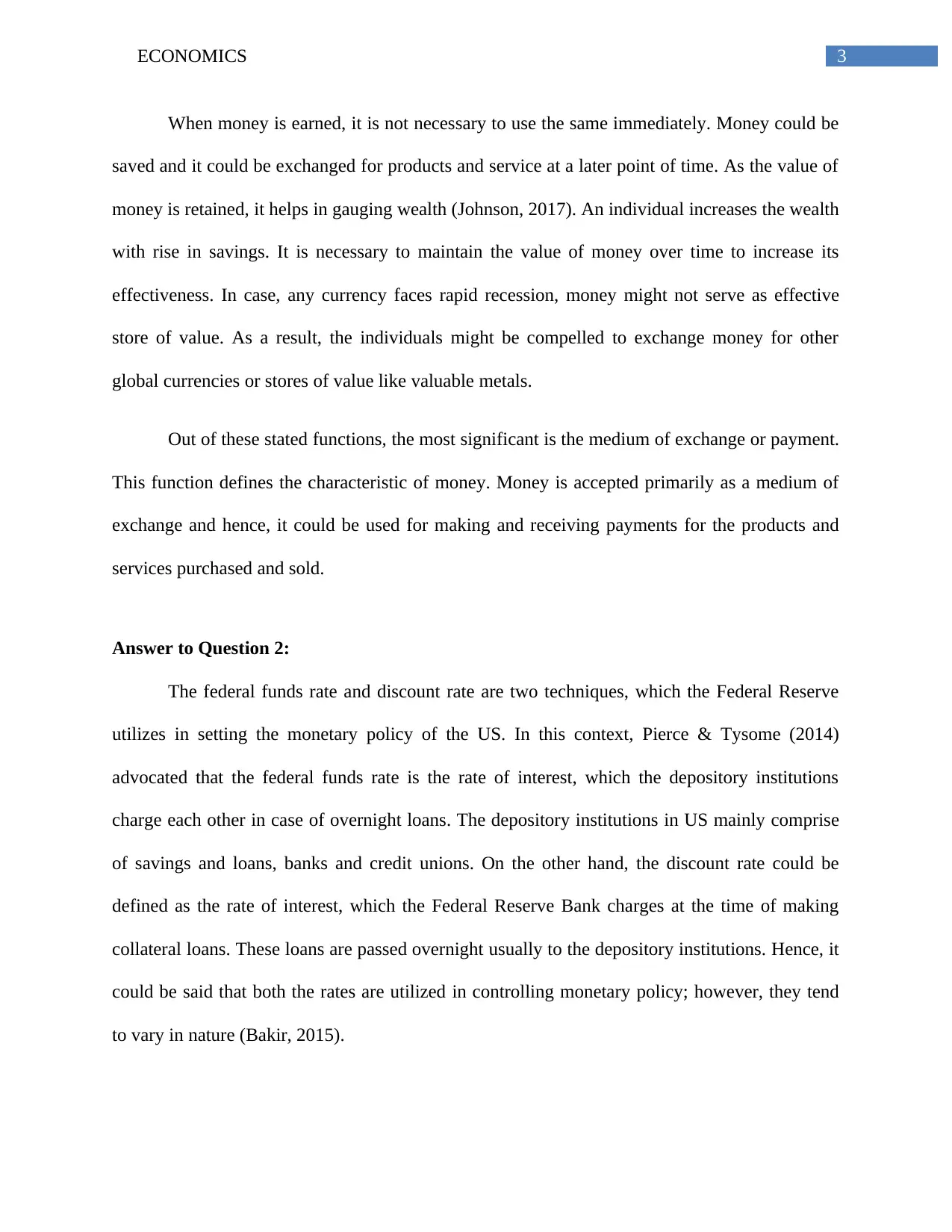
3ECONOMICS
When money is earned, it is not necessary to use the same immediately. Money could be
saved and it could be exchanged for products and service at a later point of time. As the value of
money is retained, it helps in gauging wealth (Johnson, 2017). An individual increases the wealth
with rise in savings. It is necessary to maintain the value of money over time to increase its
effectiveness. In case, any currency faces rapid recession, money might not serve as effective
store of value. As a result, the individuals might be compelled to exchange money for other
global currencies or stores of value like valuable metals.
Out of these stated functions, the most significant is the medium of exchange or payment.
This function defines the characteristic of money. Money is accepted primarily as a medium of
exchange and hence, it could be used for making and receiving payments for the products and
services purchased and sold.
Answer to Question 2:
The federal funds rate and discount rate are two techniques, which the Federal Reserve
utilizes in setting the monetary policy of the US. In this context, Pierce & Tysome (2014)
advocated that the federal funds rate is the rate of interest, which the depository institutions
charge each other in case of overnight loans. The depository institutions in US mainly comprise
of savings and loans, banks and credit unions. On the other hand, the discount rate could be
defined as the rate of interest, which the Federal Reserve Bank charges at the time of making
collateral loans. These loans are passed overnight usually to the depository institutions. Hence, it
could be said that both the rates are utilized in controlling monetary policy; however, they tend
to vary in nature (Bakir, 2015).
When money is earned, it is not necessary to use the same immediately. Money could be
saved and it could be exchanged for products and service at a later point of time. As the value of
money is retained, it helps in gauging wealth (Johnson, 2017). An individual increases the wealth
with rise in savings. It is necessary to maintain the value of money over time to increase its
effectiveness. In case, any currency faces rapid recession, money might not serve as effective
store of value. As a result, the individuals might be compelled to exchange money for other
global currencies or stores of value like valuable metals.
Out of these stated functions, the most significant is the medium of exchange or payment.
This function defines the characteristic of money. Money is accepted primarily as a medium of
exchange and hence, it could be used for making and receiving payments for the products and
services purchased and sold.
Answer to Question 2:
The federal funds rate and discount rate are two techniques, which the Federal Reserve
utilizes in setting the monetary policy of the US. In this context, Pierce & Tysome (2014)
advocated that the federal funds rate is the rate of interest, which the depository institutions
charge each other in case of overnight loans. The depository institutions in US mainly comprise
of savings and loans, banks and credit unions. On the other hand, the discount rate could be
defined as the rate of interest, which the Federal Reserve Bank charges at the time of making
collateral loans. These loans are passed overnight usually to the depository institutions. Hence, it
could be said that both the rates are utilized in controlling monetary policy; however, they tend
to vary in nature (Bakir, 2015).
Paraphrase This Document
Need a fresh take? Get an instant paraphrase of this document with our AI Paraphraser
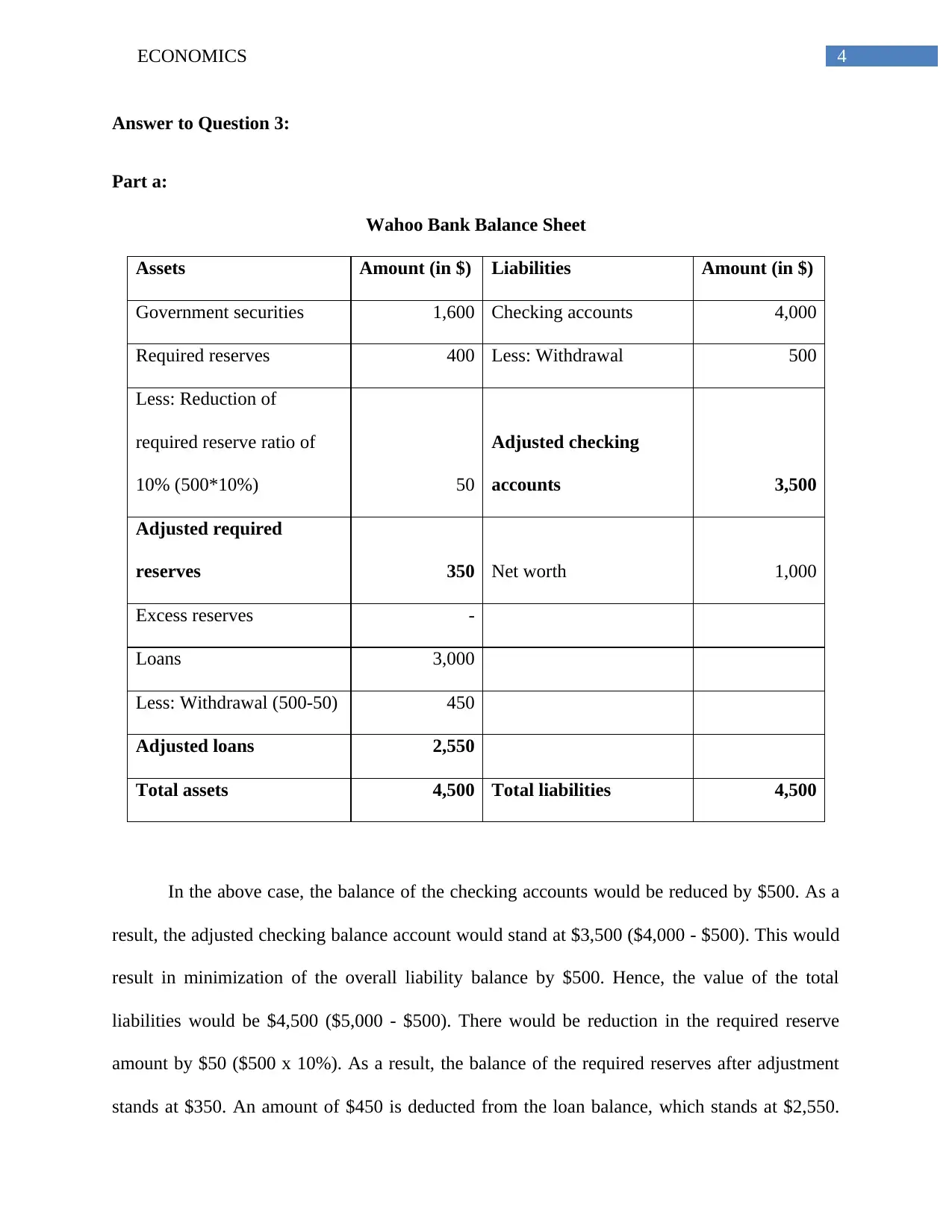
4ECONOMICS
Answer to Question 3:
Part a:
Wahoo Bank Balance Sheet
Assets Amount (in $) Liabilities Amount (in $)
Government securities 1,600 Checking accounts 4,000
Required reserves 400 Less: Withdrawal 500
Less: Reduction of
required reserve ratio of
10% (500*10%) 50
Adjusted checking
accounts 3,500
Adjusted required
reserves 350 Net worth 1,000
Excess reserves -
Loans 3,000
Less: Withdrawal (500-50) 450
Adjusted loans 2,550
Total assets 4,500 Total liabilities 4,500
In the above case, the balance of the checking accounts would be reduced by $500. As a
result, the adjusted checking balance account would stand at $3,500 ($4,000 - $500). This would
result in minimization of the overall liability balance by $500. Hence, the value of the total
liabilities would be $4,500 ($5,000 - $500). There would be reduction in the required reserve
amount by $50 ($500 x 10%). As a result, the balance of the required reserves after adjustment
stands at $350. An amount of $450 is deducted from the loan balance, which stands at $2,550.
Answer to Question 3:
Part a:
Wahoo Bank Balance Sheet
Assets Amount (in $) Liabilities Amount (in $)
Government securities 1,600 Checking accounts 4,000
Required reserves 400 Less: Withdrawal 500
Less: Reduction of
required reserve ratio of
10% (500*10%) 50
Adjusted checking
accounts 3,500
Adjusted required
reserves 350 Net worth 1,000
Excess reserves -
Loans 3,000
Less: Withdrawal (500-50) 450
Adjusted loans 2,550
Total assets 4,500 Total liabilities 4,500
In the above case, the balance of the checking accounts would be reduced by $500. As a
result, the adjusted checking balance account would stand at $3,500 ($4,000 - $500). This would
result in minimization of the overall liability balance by $500. Hence, the value of the total
liabilities would be $4,500 ($5,000 - $500). There would be reduction in the required reserve
amount by $50 ($500 x 10%). As a result, the balance of the required reserves after adjustment
stands at $350. An amount of $450 is deducted from the loan balance, which stands at $2,550.
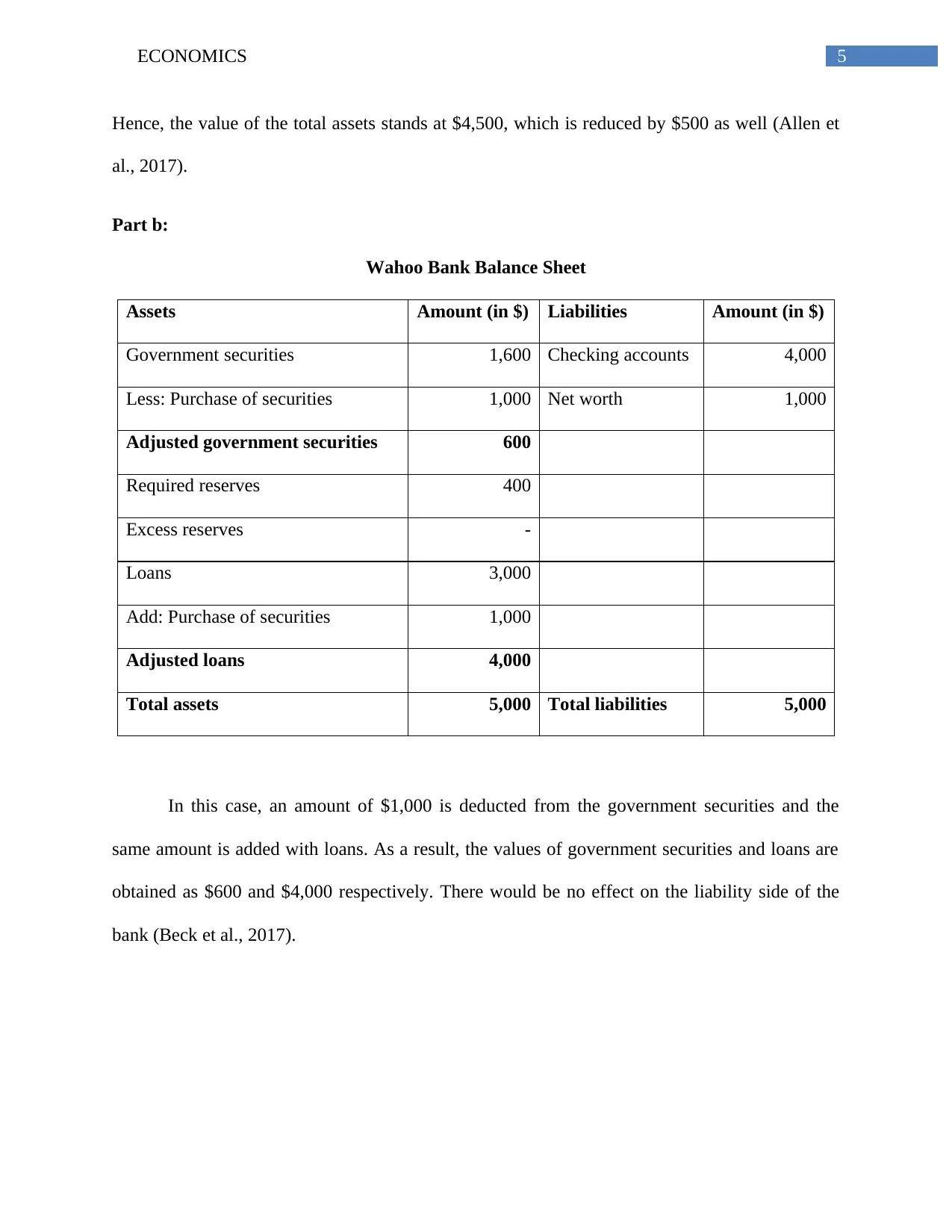
5ECONOMICS
Hence, the value of the total assets stands at $4,500, which is reduced by $500 as well (Allen et
al., 2017).
Part b:
Wahoo Bank Balance Sheet
Assets Amount (in $) Liabilities Amount (in $)
Government securities 1,600 Checking accounts 4,000
Less: Purchase of securities 1,000 Net worth 1,000
Adjusted government securities 600
Required reserves 400
Excess reserves -
Loans 3,000
Add: Purchase of securities 1,000
Adjusted loans 4,000
Total assets 5,000 Total liabilities 5,000
In this case, an amount of $1,000 is deducted from the government securities and the
same amount is added with loans. As a result, the values of government securities and loans are
obtained as $600 and $4,000 respectively. There would be no effect on the liability side of the
bank (Beck et al., 2017).
Hence, the value of the total assets stands at $4,500, which is reduced by $500 as well (Allen et
al., 2017).
Part b:
Wahoo Bank Balance Sheet
Assets Amount (in $) Liabilities Amount (in $)
Government securities 1,600 Checking accounts 4,000
Less: Purchase of securities 1,000 Net worth 1,000
Adjusted government securities 600
Required reserves 400
Excess reserves -
Loans 3,000
Add: Purchase of securities 1,000
Adjusted loans 4,000
Total assets 5,000 Total liabilities 5,000
In this case, an amount of $1,000 is deducted from the government securities and the
same amount is added with loans. As a result, the values of government securities and loans are
obtained as $600 and $4,000 respectively. There would be no effect on the liability side of the
bank (Beck et al., 2017).
⊘ This is a preview!⊘
Do you want full access?
Subscribe today to unlock all pages.

Trusted by 1+ million students worldwide
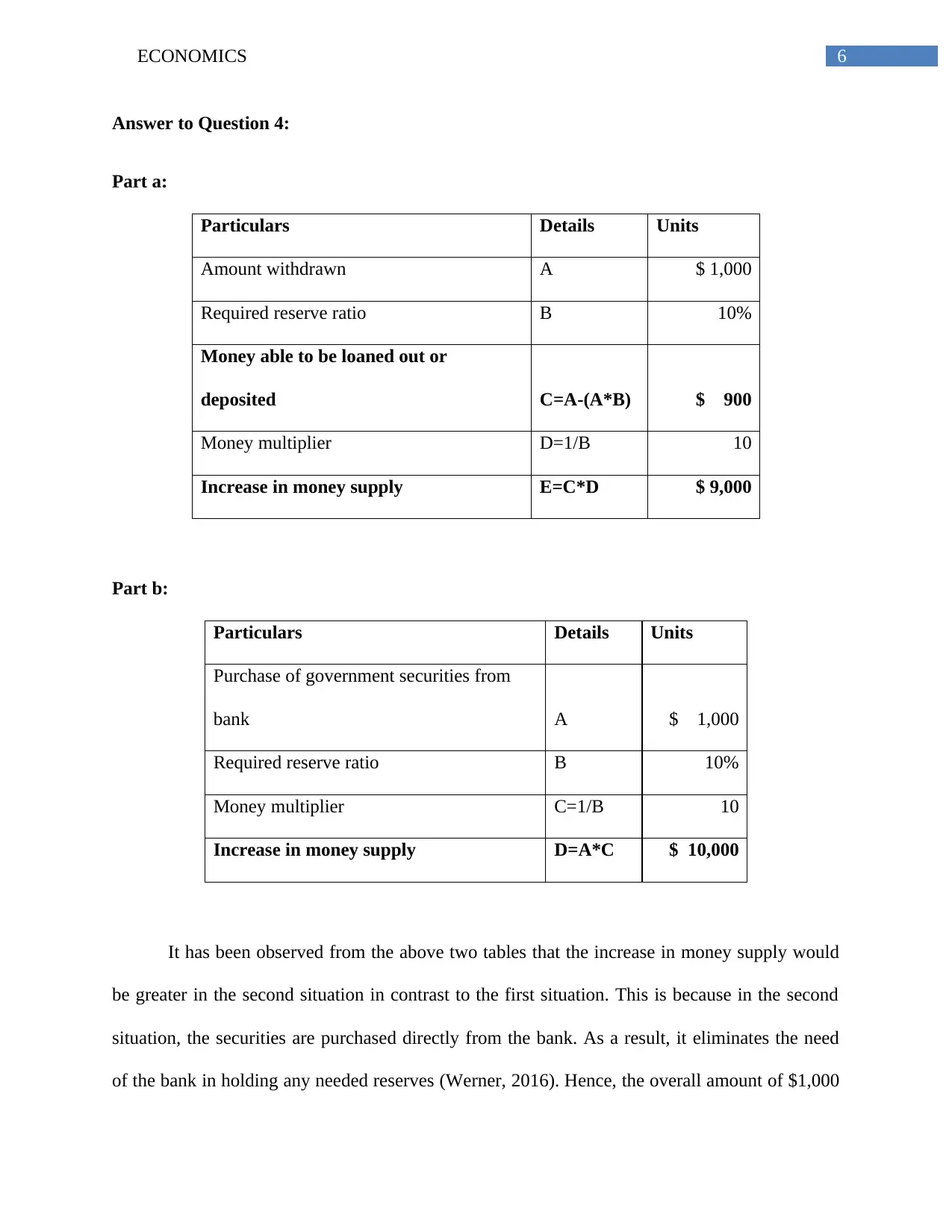
6ECONOMICS
Answer to Question 4:
Part a:
Particulars Details Units
Amount withdrawn A $ 1,000
Required reserve ratio B 10%
Money able to be loaned out or
deposited C=A-(A*B) $ 900
Money multiplier D=1/B 10
Increase in money supply E=C*D $ 9,000
Part b:
Particulars Details Units
Purchase of government securities from
bank A $ 1,000
Required reserve ratio B 10%
Money multiplier C=1/B 10
Increase in money supply D=A*C $ 10,000
It has been observed from the above two tables that the increase in money supply would
be greater in the second situation in contrast to the first situation. This is because in the second
situation, the securities are purchased directly from the bank. As a result, it eliminates the need
of the bank in holding any needed reserves (Werner, 2016). Hence, the overall amount of $1,000
Answer to Question 4:
Part a:
Particulars Details Units
Amount withdrawn A $ 1,000
Required reserve ratio B 10%
Money able to be loaned out or
deposited C=A-(A*B) $ 900
Money multiplier D=1/B 10
Increase in money supply E=C*D $ 9,000
Part b:
Particulars Details Units
Purchase of government securities from
bank A $ 1,000
Required reserve ratio B 10%
Money multiplier C=1/B 10
Increase in money supply D=A*C $ 10,000
It has been observed from the above two tables that the increase in money supply would
be greater in the second situation in contrast to the first situation. This is because in the second
situation, the securities are purchased directly from the bank. As a result, it eliminates the need
of the bank in holding any needed reserves (Werner, 2016). Hence, the overall amount of $1,000
Paraphrase This Document
Need a fresh take? Get an instant paraphrase of this document with our AI Paraphraser
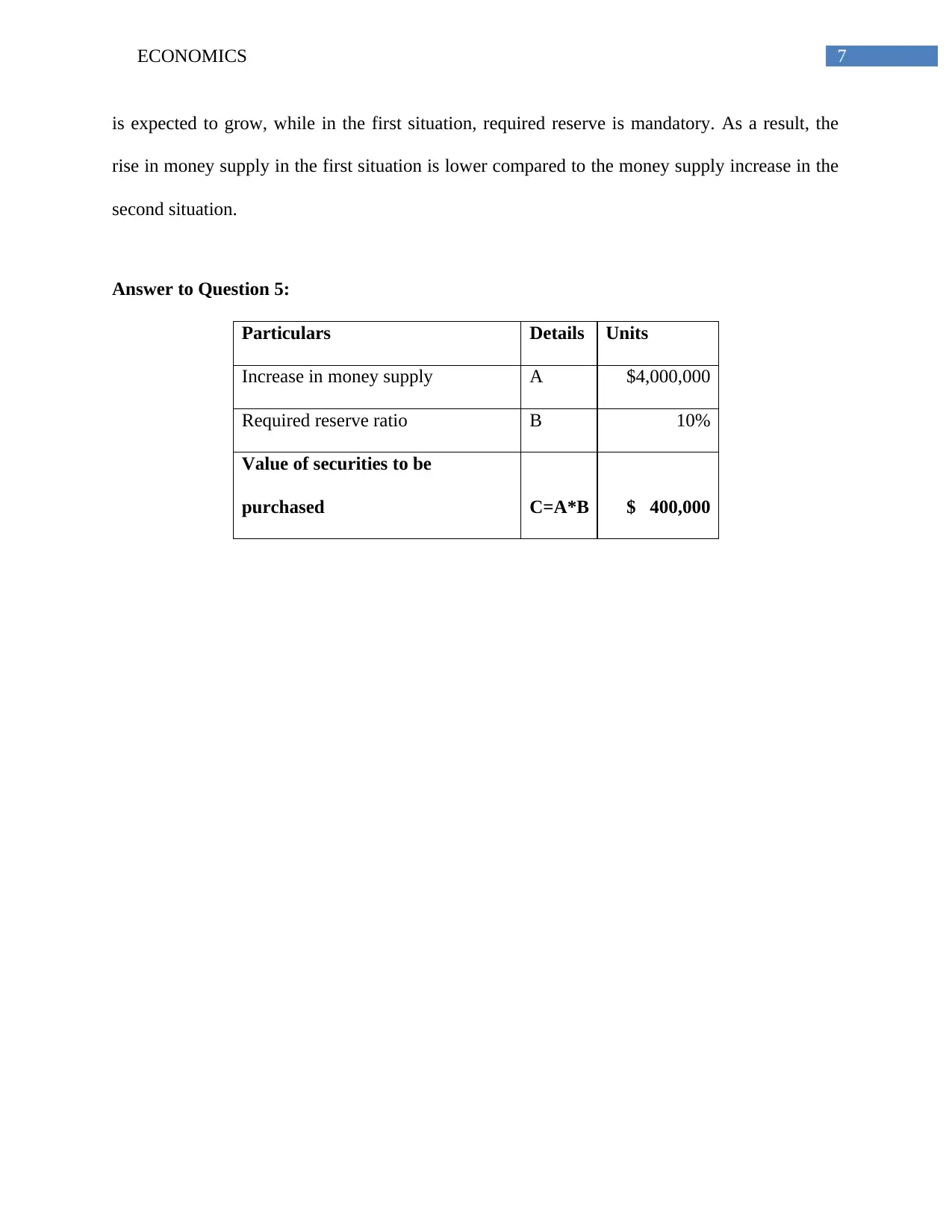
7ECONOMICS
is expected to grow, while in the first situation, required reserve is mandatory. As a result, the
rise in money supply in the first situation is lower compared to the money supply increase in the
second situation.
Answer to Question 5:
Particulars Details Units
Increase in money supply A $4,000,000
Required reserve ratio B 10%
Value of securities to be
purchased C=A*B $ 400,000
is expected to grow, while in the first situation, required reserve is mandatory. As a result, the
rise in money supply in the first situation is lower compared to the money supply increase in the
second situation.
Answer to Question 5:
Particulars Details Units
Increase in money supply A $4,000,000
Required reserve ratio B 10%
Value of securities to be
purchased C=A*B $ 400,000
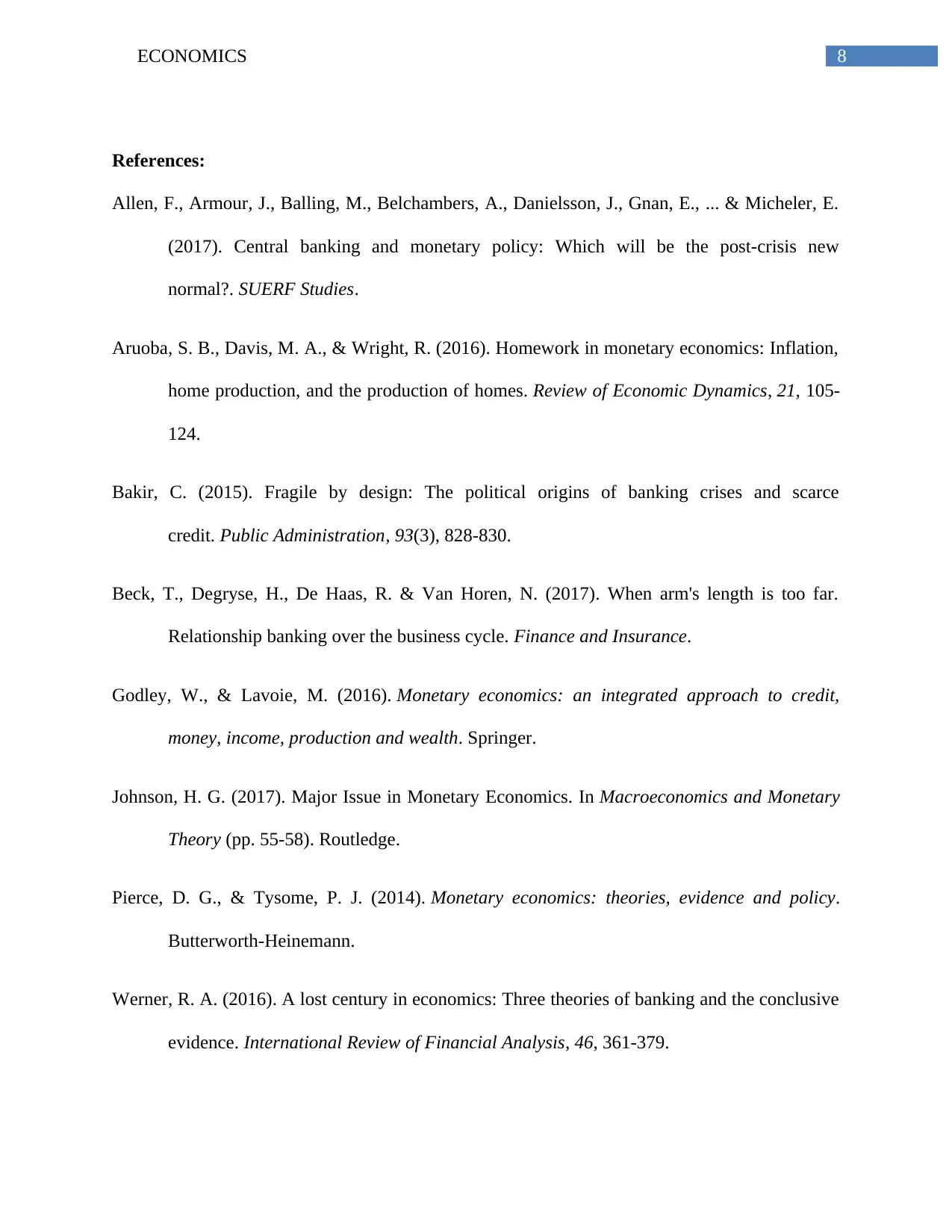
8ECONOMICS
References:
Allen, F., Armour, J., Balling, M., Belchambers, A., Danielsson, J., Gnan, E., ... & Micheler, E.
(2017). Central banking and monetary policy: Which will be the post-crisis new
normal?. SUERF Studies.
Aruoba, S. B., Davis, M. A., & Wright, R. (2016). Homework in monetary economics: Inflation,
home production, and the production of homes. Review of Economic Dynamics, 21, 105-
124.
Bakir, C. (2015). Fragile by design: The political origins of banking crises and scarce
credit. Public Administration, 93(3), 828-830.
Beck, T., Degryse, H., De Haas, R. & Van Horen, N. (2017). When arm's length is too far.
Relationship banking over the business cycle. Finance and Insurance.
Godley, W., & Lavoie, M. (2016). Monetary economics: an integrated approach to credit,
money, income, production and wealth. Springer.
Johnson, H. G. (2017). Major Issue in Monetary Economics. In Macroeconomics and Monetary
Theory (pp. 55-58). Routledge.
Pierce, D. G., & Tysome, P. J. (2014). Monetary economics: theories, evidence and policy.
Butterworth-Heinemann.
Werner, R. A. (2016). A lost century in economics: Three theories of banking and the conclusive
evidence. International Review of Financial Analysis, 46, 361-379.
References:
Allen, F., Armour, J., Balling, M., Belchambers, A., Danielsson, J., Gnan, E., ... & Micheler, E.
(2017). Central banking and monetary policy: Which will be the post-crisis new
normal?. SUERF Studies.
Aruoba, S. B., Davis, M. A., & Wright, R. (2016). Homework in monetary economics: Inflation,
home production, and the production of homes. Review of Economic Dynamics, 21, 105-
124.
Bakir, C. (2015). Fragile by design: The political origins of banking crises and scarce
credit. Public Administration, 93(3), 828-830.
Beck, T., Degryse, H., De Haas, R. & Van Horen, N. (2017). When arm's length is too far.
Relationship banking over the business cycle. Finance and Insurance.
Godley, W., & Lavoie, M. (2016). Monetary economics: an integrated approach to credit,
money, income, production and wealth. Springer.
Johnson, H. G. (2017). Major Issue in Monetary Economics. In Macroeconomics and Monetary
Theory (pp. 55-58). Routledge.
Pierce, D. G., & Tysome, P. J. (2014). Monetary economics: theories, evidence and policy.
Butterworth-Heinemann.
Werner, R. A. (2016). A lost century in economics: Three theories of banking and the conclusive
evidence. International Review of Financial Analysis, 46, 361-379.
⊘ This is a preview!⊘
Do you want full access?
Subscribe today to unlock all pages.

Trusted by 1+ million students worldwide
1 out of 9
Related Documents
Your All-in-One AI-Powered Toolkit for Academic Success.
+13062052269
info@desklib.com
Available 24*7 on WhatsApp / Email
![[object Object]](/_next/static/media/star-bottom.7253800d.svg)
Unlock your academic potential
Copyright © 2020–2025 A2Z Services. All Rights Reserved. Developed and managed by ZUCOL.





